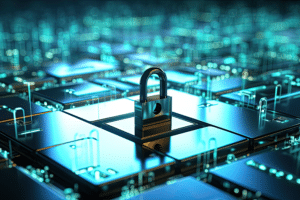Cross Domain Solutions: What They Are, How They Work, and What Makes Them Effective
12:11:2023
Whether in military or intelligence missions or in globally linked enterprises, we increasingly rely on secure information sharing across different sectors for effective execution. However, the very agencies and industries that handle sensitive data are targets for cybercriminals. As these attacks are supported by AI nowadays, those who want to protect this intel face ever greater challenges.
Cross domain solutions (CDS) aim to mitigate these risks by facilitating secure communication between otherwise disparate systems and domains. Essentially, they give you the option to work interconnectedly without experiencing the drawbacks of an entirely open web.
To guarantee the data security of government entities, you need a technically sound system that employees can understand. Therefore, we’d like to explain the most important technical building blocks of a CDS. On top of that, we’ll identify any possible vulnerabilities during the implementation phase, so you can be confident in the safety of your data.
When Do You Typically Need a Cross Domain Solution?

Typically, cross domain technology aims to restrict access or data transfer rights to increase integrity and confidentiality.
As with any type of technology, there’s no one universal cross domain solution. So, to understand whether you actually need one, you should first know about the underlying technologies.
Typically, cross domain technology aims to restrict access or data transfer rights to increase integrity and confidentiality. That’s why these solutions are most often used for exchanges between the different networks within our intelligence agencies and military. These entry points allow for a pathway between one classified network and the next while adapting to the mission needs of various federal agencies. Still, they’re also deployed to protect critical systems in industrial organizations. Due to the high standards for data integrity and availability in these sectors, a CDS protects the information exchange with several simultaneous security measures.
The solution can safeguard both one-way and bidirectional transfers between multiple domains, but the underlying policy ultimately determines the criteria for a successful transaction, and thus, the level of security. The governing policy may only dictate a simple antivirus check or go as far as demanding approval by a dedicated specialist.
Implementing Standards and Tests Reflecting Your Security Needs
Since the acceptance standards you establish for your needs will define the appropriate solutions, your integrity and confidentiality requisites will have the biggest impact on your system design. You may need advanced content filtering or whitelisting features for trusted applications to go beyond the basic protection of an automated malware check.
All of these requirements have to be thoroughly tested during a lab-based security assessment (LBSA). The point is to run your hardware and software through various security-impacting scenarios in a controlled environment before installing the solution. The LBSA labs that you’d use for this procedure are managed by the National Cross Domain Strategy and Management Office (NCDSMO).
For military forces, CDS systems often are part of an overarching risk management framework strategy for secure information sharing between different security domains, thus improving collaboration and providing context for operations in real time. In law enforcement, the same seamless integration of databases allows personnel to cross-reference records across agencies and jurisdictions without compromising classified information or personal data.
A secure data exchange can also be beneficial for the manufacturing sector, where supply chain management involves collaboration with multiple business partners. A CDS can enable more secure exchanges between diverse industry-specific networks while providing valuable data to assist with the detection of insider threats.
How Do Cross Domain Solutions Guarantee Security?
There are different cross-domain implementation models, each with its own set of advantages and disadvantages.
- Hardware-based CDS: These solutions typically provide the highest security standards, although they might require more maintenance efforts. Their higher performance often makes them an ideal choice for military operations, but they can be tailored to other specific security requirements.
- Software-based CDS: Instead of using hardware to implement security policies, these systems rely on software written on top of an operating system. This facilitates easier integration with existing hardware, but also renders them more prone to software flaws and software-based attacks.

If your team members only need remote desktop access, an access CDS will provide the necessary security protocols and sanitization options to guide that procedure.
Once you’ve decided on the deployment implementation, you need to choose between an access and a transfer CDS. Ultimately, this choice depends on the tasks your personnel are required to perform.
If your team members only need remote desktop access, an access CDS will provide the necessary security protocols and sanitization options to guide that procedure. However, if the task at hand requires users to sanitize data objects like Word documents or email messages, they’ll need a transfer solution to properly transfer the data between domains.
In addition to this basic infrastructure, your solution may combine various feature sets to guarantee security. Through data sanitization techniques, the CDS may irreversibly remove, overwrite, or destroy parts of the transferred data. This prevents leaks and the spread of malware.
By combining robust authentication mechanisms with encryption techniques and workflows for policy enforcement, the CDS will further reduce the risk of unauthorized access.
Security Challenges During System Implementation, and How To Overcome Them
To meet all the aforementioned security standards, a systematic approach to implementation is needed. Like any system change, this one should start with a thorough needs analysis and documentation of your current setup.
For optimal results, you’ll have to integrate different systems from various domains. Therefore, compatibility issues in data formats and security protocols aren’t the exception but the rule. Make sure you’re aware of your technical requirements and possible alternatives to currently implemented solutions before the transition. If the existing systems can’t be changed, you should ensure that your solution includes the appropriate data mapping and transformation features to support a seamless exchange between various file formats.
Be aware that sensitive data might be exposed during the CDS implementation. The National Cross Domain Strategy & Management Office (NCDSMO) has produced guidance that explains what you need to do in order to protect your systems as you develop your CDS. While creating this environment is challenging, it is important to protect the solution.
Bear in mind that the best system won’t provide any protection unless each individual user supports your standards. Depending on their technical knowledge and background, different employees may be resistant to switching to an unfamiliar system. They may even avoid using the new system out of a sense of duty, because they don’t trust the security standards. Allow enough time for a transition and training period during which you can sufficiently introduce personnel to safety practices and unknown features.
Through a proper change management plan, you can address potential resistance by communicating the benefits early on, and then continuously provide support during the transition.
Also, keep in mind that your needs as an organization will change over time. Whether you need to handle a larger volume of data or multiple locations, make sure your system can grow with you. Consider the different scaling capabilities of the deployment models discussed above.
Finally, work closely with your legal and compliance teams even when evaluating various options on the market. The cybersecurity performance goals for critical infrastructure entities will vary greatly from those in the DoD, and they’ll constantly change. Make sure your CDS allows you to regularly review and update settings and policies accordingly, so you can stay compliant.
Guard Yourself Against Unauthorized Access
CDS systems can greatly enhance security in cross-industry and cross-agency communications, but they require a thorough analysis of the technical prerequisites. We hope we’ve been able to make a contribution to your understanding.
If you’d like to learn more about CDS solutions or know how a solution could be adapted to the specific requirements of your company or agency, please contact our team.
Related Articles
Leveraging Supercomputers on Demand for Advanced Defense Capabilities
The defense landscape is evolving rapidly, and developers are just getting started applying computational power to long-standing challenges, from real-time threat detection to advanced simulations. While traditional computing solutions will…
Navigating the Surge in Chinese High-Tech Exports
The global technological landscape is undergoing a significant transformation, with China’s high-tech export surge at the forefront of this shift. While this surge highlights the nation’s growing influence in advanced…
Enabling Communication Through Clogged Networks in Military Communications
In high-stakes military operations where rapid response and coordination can determine the outcome of a mission, seamless communication is critical. But in today’s digitally saturated battlefield, clogged networks and data…
Could your news use a jolt?
Find out what’s happening across the cyber landscape every month with The Lightning Report.
Be privy to the latest trends and evolutions, along with strategies to safeguard your government agency or enterprise from cyber threats. Subscribe now.